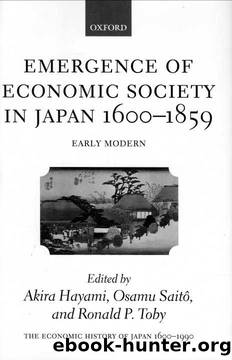The Economic History of Japan: 1600-1990: Volume 1: Emergence of Economic Society in Japan, 1600-1859 (The Economic History of Japan, 1660-1990) by Unknown

Author:Unknown
Language: eng
Format: epub
Published: 2008-10-06T13:42:00+00:00
2. The Accounts Structure in 1730 and the Kyoho Reforms
The Osame-harai kanjoch8 (The Income and Expense Account Book, 1730), which has survived in the family of the Kyoho-era senior councilor (roj(i), Matsudaira Nobutoki, is the only remaining record that tells of the accounts of shogunal finances from the early eighteenth century (Ono 1971: 42-64). 1 would like to use this account book to take a concrete look at the particularities of shogunal finances (Oguchi 1969: 15-75).
Since the form of tax submissions at the time was divided into rice submissions and gold submissions, shogunal budgets were also divided into rice and cash (gold and silver) portions. According to Table 6.1, the rice portion showed a total income of 854,000 koku, which contained a breakdown of 500,000 koku of annual rice taxes (nengu, collected the year before) and 281,000 koku of purchased rice. The purchased rice was a shogunal policy adopted that year in response to the decline in the price of rice. In normal years, the annual rice tax occupied close to 90 per cent of the rice income. Expenditures totaled 592,000 koku, which included a breakdown of 312,000 koku for various forms of rice stipends (kirimai, yakuryo, goriki- niai, and so on) for bannermen and vassals, and 203,000 koku of sold rice. Thus, over half of the rice collected as rice tax from Tokugawa domain villages went to support the bannermen and vassals.
What about the cash portion of the budget? First, as I stated above, the basic structure of domainal finances was that annual taxes were collected from villages in the domain and these were then used to pay stipends to direct retainers, cover the private expenses of the lord, and cover administrative costs. Looking at Table 6.2 on this basis, tax income was 509,000 re/u and stipends, private expenses, and administrative costs were nearly equal, at a total of 506,000 n/O. Taken together, annual expenses maintained a high ratio of three to two in relation to income. Thus, the shogunal budget in this period still retained a deeply traditional character. Let us look next at the main expense items.
Download
This site does not store any files on its server. We only index and link to content provided by other sites. Please contact the content providers to delete copyright contents if any and email us, we'll remove relevant links or contents immediately.
Pale Blue Dot by Carl Sagan(4865)
The Rules Do Not Apply by Ariel Levy(4795)
Goodbye Paradise(3672)
Ogilvy on Advertising by David Ogilvy(3464)
Delivering Happiness by Tony Hsieh(3337)
Liar's Poker by Michael Lewis(3330)
Into Thin Air by Jon Krakauer(3268)
Purple Cow by Seth Godin(3112)
Rogue Trader by Leeson Nick(2950)
The Social Psychology of Inequality by Unknown(2906)
The Airbnb Story by Leigh Gallagher(2757)
4 - Harry Potter and the Goblet of Fire by J.K. Rowling(2620)
The Mind Map Book by Tony Buzan(2476)
Bossypants by Tina Fey(2429)
Claridge's: The Cookbook by Nail Martyn & Erickson Meredith(2323)
All the President's Men by Carl Bernstein & Bob Woodward(2304)
Six Billion Shoppers by Porter Erisman(2246)
Master of the Game by Sidney Sheldon(2209)
Alibaba by Duncan Clark(2006)
